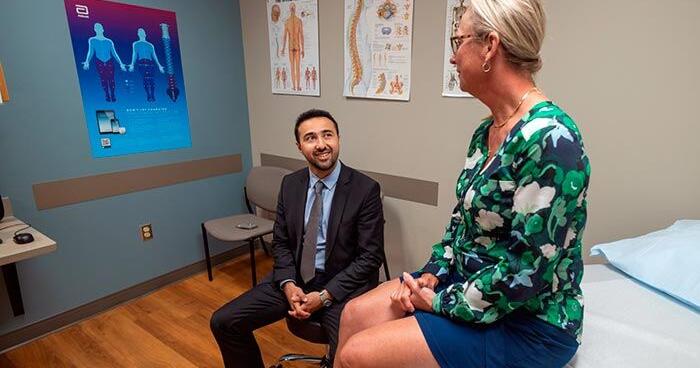A Norfolk doctor has conducted the first peripheral nerve stimulation (PNS) implant in Northeast Nebraska.
Dr. Ihsan Balkaya, who is with Faith Regional Physicians Services, focuses on pain management, with his residency being physical medicine and rehabilitation. He did a fellowship in Wisconsin and, for the past two years, he’s been with Faith Regional.
He focuses on a spectrum of pain problems, ranging from cancer pain to arthritis to migraines. He uses neuromodulation, involving the stimulators, for different nerve problems and trials of those two.
He said the PNS implant involves peripheral nerves, which run away from the spine, such as those running down arms and legs. The stimulation part comes from a small stimulator, which places a small lead next to the nerves.
Balkaya said this idea comes from something called the spinal cord stimulator. That procedure has been around for almost 20 years and involves placing those small electric leads down the spinal cord. Those leads then create a stimulation pattern that effectively blocks the brain from receiving some pain signals.
“So you have a pain that’s picked up by the nerve, the nerve goes to the spinal cord and that goes to the brain and you feel the pain,” Balkaya said. “That stimulator lead is in the way that it kind of blocks and regulates, you could even say, the nerve signals, the pain signals only before they get to your brain, and it helps with the pain.”
Balkaya said there are differences between the PNS implant and the spinal cord stimulator. PNS is used when there is a localized, specific point of trauma. He said the implantation is easy, with the lead being able to fit through a needle. And a patient is back to normal in no time.
He said the procedure involves placing a needle near the affected nerve, feeding the lead through the needle and then removing the needle so it stays there. The stimulator is turned on to the correct frequency that will best help the patient. Balkaya said it;s a short procedure, 15-20 minutes tops.
There is a trial period, where the lead is implanted, and it stays in for a three-month period. It is tested, and the patients will see relief even after the lead is pulled out after the three-month trial period.
“It kind of helps rearranging their pain signals between that nerve and the brain so it kind of regulates everything,” Balkaya said.
If the pain comes back in a year, for example, doctors will look at a more permanent option, which involves putting the lead back in, with a small generator somewhere nearby to power the lead.
Balkaya said the patients would return after a week and be monitored every month. The most common complication is the lead migrates away from the nerve and therefore doesn’t provide the relief needed.
Alleviating someone’s pain can benefit a person. That pain can cause someone to be more sedentary, opening the door for other medical risks such as infections, diabetes and heart and lung problems. He added that one of the benefits is lowering a person’s health cost as well avoiding these risks through pain relief.
“It’s not quite as simple as saying pain relief,” Balkaya said. “Basically, I think it increases their life quality, life expectancy.”
Those eligible would show from their medical history that complaints stem from a single nerve down the arms or legs, allowing him to place the lead close to the affected nerve.
There are few things that would limit someone who qualifies from that first step to be able to get this procedure. The biggest obstacle for someone getting this is insurance.
Dr. Ihsan Balkaya, who is with Faith Regional Physicians Services in Norfolk, conducted the first peripheral nerve stimulation (PNS) implant i…
Balkaya said he learned and was trained on this from his fellowship and that this ultimately is new technology, placing the leads peripherally along the nerve rather than on the spinal cord as done previously.
Balkaya said that because this is new technology, they still have to wait for more insurance companies to make it available.
“Sometimes you can’t offer it to people who really need it,” Balkaya said.
He spoke on the process of bringing this procedure to Faith Regional. He spoke to companies to bring in the leads needed, and Faith Regional helped out immensely, doing its part to help bring the leads here.
The first patient to undergo the procedure at Faith Regional had the implant around two months ago and saw tremendous relief, Balkaya said, with the source of the pain coming from the toes.
“She said she was walking barefoot for the first time after five years, right after placing that and turning it off,” Balkaya said.
Balkaya said he was happy for the patient feeling that relief and was happy about bringing this new technology to the community
“Bringing this technology, this therapy to our community, was, you know, was a very kind of thrilling and kind of satisfying for the caregiver,” Balkaya said.
Balkaya said the goal is for this to be more regularly offered at Faith Regional. The other goal is that because Faith Regional has only the temporary leads that are taken out after three months, the hospital is in talks to get, and offer, the more permanent lead options.
Balkaya said the goal with the community is to reach out to those dealing with trauma affecting their nerves in the arms and legs who think nothing can be done and have to live with their pain. He added that there is always new medicine coming out, but most people aren’t aware of it.
“We have this available now, and I’m just hoping to reach out to them so that they can get some relief,” Balkaya said.
link

